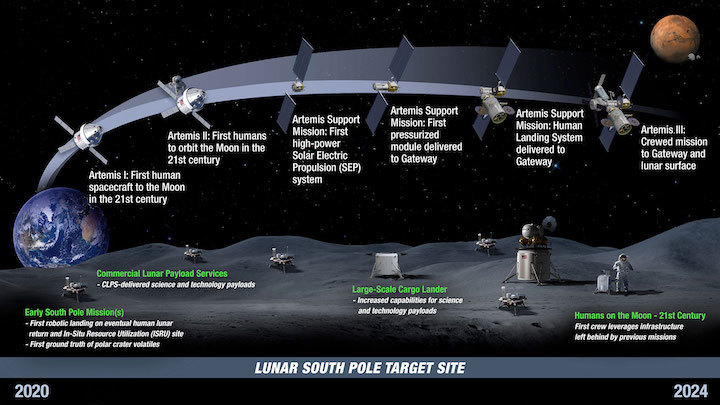8.12.2019

NASA is seeking proposals for human lunar landing systems designed and developed by American companies for the Artemis program, which includes sending the first woman and next man to the surface of the Moon by 2024.
The final call to industry comes after NASA issued two drafts on July 19 and Aug. 30, encouraging companies to send comments to help shape a key component of the agency’s human exploration Artemis partnerships. NASA is expected to make multiple awards to industry to develop and demonstrate a human landing system. The first company to complete its lander will carry astronauts to the surface in 2024, and the second company will land in 2025.
Proposals to build a landing system are due Nov. 5—an ambitious timeline consistent with the sequence of events leading to this point—however, companies have been preparing for, reviewing, and commenting on several drafts of NASA’s broad agency announcement since mid-July and should be ready for this tight timeline.
“In order to best accelerate our return to the Moon and prepare for Mars, we collaborated with industry on ideas to streamline the procurement process,” said Marshall Smith, director of the Human Lunar Exploration Program at NASA Headquarters in Washington. “The private sector was eager to provide us feedback throughout this process, and we received more than 1,150 comments on the draft solicitations issued over the summer.”
Typical spaceflight hardware can take six to eight years to develop. With less than five years to land astronauts on the Moon, every word and requirement counts.
After reviewing the comments, NASA removed requirements that industry perceived as potential barriers to speed while preserving all the agency’s human safety measures. For example, industry stated that delivery of a high number of formal technical reports would require a company to spend considerable resources and incur undue schedule risk. Taking this into consideration, NASA has designed a less formal insight model that will be used for accessing critical contractor data while minimizing administrative overhead. As a result, NASA reduced the number of required contract deliverables from 116 to 37.
“Reports still are valuable and necessary, but to compromise and ease the bulk of the reporting burden on industry, we are asking for access to the companies’ systems to monitor progress throughout development,” said Nantel Suzuki, the Human Landing System program executive at NASA Headquarters in Washington. “To maximize our chances of successfully returning to the Moon by 2024, we also are making NASA’s engineering workforce available to contractors and asking proposers to submit a collaboration plan.”
When called to accelerate its return to the Moon, NASA said it would meet this ambitious goal by “any means necessary.” The agency’s preferred approach to a lunar landing is for the crew in the Orion spacecraft and the uncrewed human landing system to launch separately and meet in lunar orbit at the Gateway, which is critical to long-term exploration of the Moon. NASA wants to explore all options to achieve the 2024 mission and remains open to alternative, innovative approaches.
Another shift centered around how to best achieve sustainability on the Moon by 2028. In addition to greater performance, such as global lunar surface access and higher payload mass capacity, NASA originally required the Human Landing System to be refuelable as a means to ensure a more sustainable exploration architecture. Multiple companies had concerns about this requirement, and NASA agreed to remove it so that industry has greater flexibility to address the more fundamental attribute of sustainability, which is long-term affordability.
“They were absolutely right,” said Lisa Watson-Morgan, the Human Landing System program manager at NASA’s Marshall Spaceflight Center in Huntsville, Alabama. “We are operating on a timeline that requires us to be flexible to encourage innovation and alternate approaches. We still welcome the option to refuel the landing system, but we removed it as a requirement.”
NASA’s Artemis program includes sending a suite of new science instruments and technology demonstrations to study the Moon, landing the first woman and next man on the lunar surface by 2024, and establishing a sustained presence by 2028. The agency will leverage its Artemis experience and technologies to prepare for the next giant leap – sending astronauts to Mars.

Quelle: NASA
